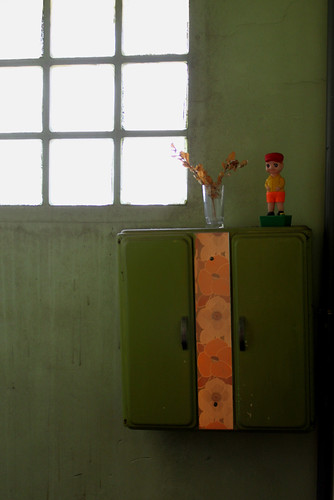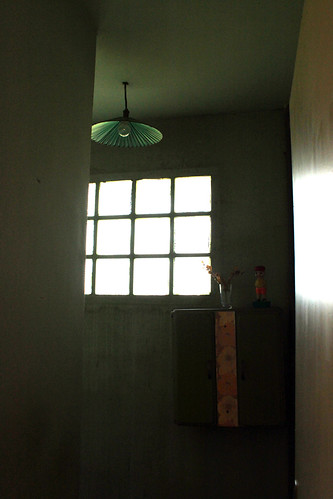I am French but have been living in England for 4 years. Like Andre Breton and Louise Bourgeois, I first succumbed to the French reverence for Rationality and Science, and studied Mathematics before turning to Art
I originally trained as a software engineer specialising in audio applications, such as audio effects. In that field, I developed a special interest in physical modellisation and synthetic generation of sound, which means artificially copying the physical way the sound is produced in order to synthesize realistic sounds. In particular, I programmed a seascape sound of crashing waves and shrieking seagulls randomly generated from filtered white noise and variable frequency sine waves. It was shown at FILE electronic arts festivals in Sao Paulo (Brazil) last summer. I have been learning classical singing for years, and try and use the techniques in cabaret and folk singing. I hope to be able to use these skills to make video soundtracks.
In parallel, I have been making Art since 2006 using both traditional and digital media. I am interested in Surrealism, Raw Art, Symbolism, Romanticism, German Expressionism, generally any kind of art that deals with the unconscious, madness, death, alienation and the strange. Although some of my work is directly linked to Traditional Surrealism, such as documenting my dreams in paintings, my interest also lies in exploring the relevance of Surrealism to Contemporary Culture, and experimenting with its principles in the context of new Art Forms such as Ecological Art and Urban Exploration. While modern culture is obsessed with efficiency and control, I explore the random and the unpremeditated which, contrary to the controlled images produced by our culture, can spark questioning and reverie in the mind of the observer. Weary of any kind of control, I usually do not tell the audience what my Art is about or what they should see in a particular piece. I like Art that is open to interpretation, and hope the viewer will see some of their own experiences and obsessions resonate in my work, or will enjoy it as a purely aesthetic product if they wish.
In the tradition of Surrealism, I document my dreams in drawings and paintings. It is a process of archivism: the form is purely serving the clarity and accuracy of the subject. Formalisation is used to piece together imperfect fragments of memories into a coherent picture, but any other kind of post-processing or aesthetisation is rejected.

Because I had no formal art training before starting this MA, I got very interested in Raw Art. I used some of the concept of Raw Art in my own practice such as working with found objects (Objets Trouvés) and a fascination with the workings of children’s mind when they are free to express themselves without the layer of sugariness artificially imposed on them by adults. In particular I have been making mixed media assemblage called “twisted toys”.

In my 3D practice, I mainly make “random natural sculpture” with wood: I bring back dead wood with interesting shapes, and at first spend up to several months (depending on the degree of decay) alternatively letting the outer layer dry, then scrapping out the rotten bits, until what is left is healthy enough to make a durable artwork. By then, the selection dictated by the law of biology has most of the time led to the embryo of a meaningful shape, and I add my own input to enhance its features. Since visiting Ireland, I have developed an interest in bogwood (very old wood kept from rotting because it has been buried in acidic soil) which can also be found in the Fens where I live, and I am experimenting with the possibilities of this new material. I call these sculptures “Nature Morte” which is the French word for “Still Life” but the literal translation is “dead life”. The name hints to the process of decay I use in my “random natural sculptures”, and also ironically refers to a classic highly aesthesized Art Genre traditionally used to display wealth and luxury. I am fascinated with finding harmonious proportions and balanced composition in object usually dismissed as rubbish.

I am involved in a collaborative project with Bill Cox, exploring the darker side of ‘Cabaret’ and playing with German Expressionnism in a multimedia context. It is an ongoing project and we plan to use video, photography, music and performance in various context. So far, we have projected German expressionists movies on a homemade Cabaret stage with a performer (me) doing various acts in front of the screen. The performer was present at the same time on stage outside of the film reality but also on screen in the form of a shadow fully part of the movie’s self contained world. One could read into it a reference to the Doppelgänger (the Double).
My lens-based work is about documenting the irruption of the imaginary in the physical world, an observation of the ambiguous, fluctuating line between the mainstream, accepted vision of things and the individual’s perception of it. Photography and video, media traditionally considered “objective”, always at the crossroads between art and documentary, are ironically adapted to this mindset of systematic questioning.
The ghost house series, a work in progress since 2007, was shot at several abandoned houses in Kerry and Connemara, Ireland, whose last occupants probably left 10 to 30 years ago. Traces of their lives and aspirations, and of the disillusions and hardships that made them leave their homeland, remained in the form of scattered personal belongings. These abandoned houses are the only museums to document the social changes that took place in Ireland during the last 30 years, as the country itself tends to sacrifice the memory of its tumultuous past for the Cult of “Progress” and “Dynamism”.





